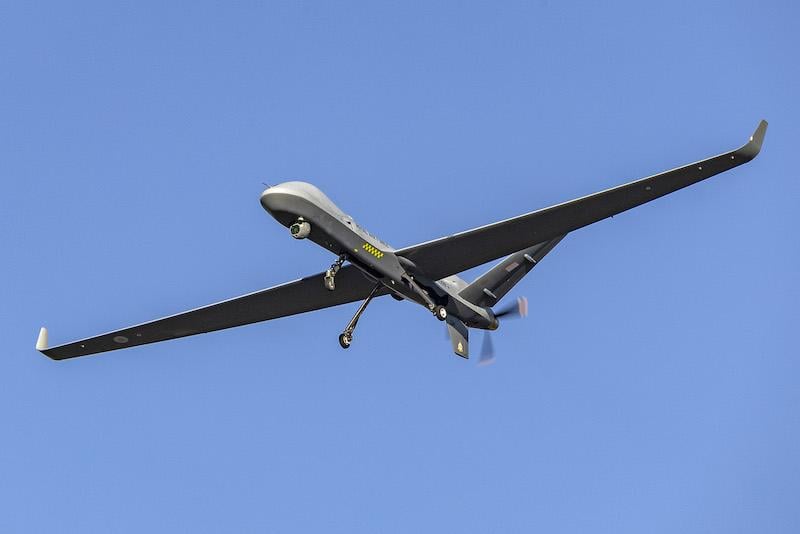
Development of the so-called Sea Protector capability is expected to take two-to-three years—and, if successful, the RAF could then purchase the wing kits to enable carrier operations.
The UK is investigating options to give its new fleet of General Atomics Protector uncrewed aircraft systems (UAS) sea legs, with a vision to operate the platform from the country’s two aircraft carriers.
Inspired by the successful landing and takeoff of General Atomics’ Mojave short-takeoff-and-landing demonstrator using an MQ-1C Gray Eagle UAS with a modified, high-lift wing onto HMS Prince of Wales in November 2023, General Atomics is self-funding the development of a similar high-lift wing for the MQ-9B SkyGuardian, the platform on which the Protector is based.
Development of the so-called Sea Protector capability is expected to take two to three years. The UK Royal Air Force (RAF) could then purchase the wing kits to enable carrier operations.
“This is a capability I would like to have in service in 2028,” Air Commodore Alex Hicks, the RAF’s head of capability delivery for intelligence, surveillance and reconnaissance (ISR) aircraft, told Aviation Week on the eve of Farnborough Airshow. The project is not yet funded and would be subject to the Strategic Defense Review, he noted.
As well as the wings, the proposed kit also includes modifications to the tail to add a skid, a main wing folding mechanism and modifications to the flight control system.
General Atomics has previously proposed the development of the kit to the U.S. Marine Corps, but it failed to gain traction at the time.
For the RAF, adding the capability would further broaden the capabilities of the 16-strong fleet of Protectors on order. Two of the aircraft have already been delivered to the UK, and other eight are flying in the U.S. Five more Protector air vehicles are due to be delivered by the end of the year to RAF Waddington, the main operating base.
The RAF has so far performed a single Protector flight in the UK, but flight operations are expected to step up in the coming weeks, with plans for 120 hr. of Integrated Test Evaluation and Acceptance flights in UK airspace to be performed by 56 Sqdn., a test and evaluation unit specializing in ISR capabilities.
Other milestones planned before the end of the year are weapons trials with the MBDA Brimstone air-to-surface missile and the Raytheon Paveway IV precision-guided bomb due to take place in the U.S.
Due to an unforeseen closure of U.S. Air Force Test Ranges required to clear the weapons, the RAF is extending operations with the MQ-9 Reaper by another six months from April to October 2025, while the timetable for final operating capability is being affected by the dramatic inflation in building costs caused by the COVID pandemic.
Nonetheless, the RAF aims to achieve initial operating capability in the 2025 fourth quarter and seeks to deploy the platform into a theater—although officials will not be drawn on where. However, the Reaper is currently being used on Operation Shader against the remnants of the Islamic State militant group in Iraq and Syria.
The RAF also is planning to invest in a detect-and-avoid system to look out for non-communicative aircraft, paving the way for the Protector fleet to operate in non-segregated airspace. Plans to provide the Protector with a maritime surveillance capability using a surface search radar are also progressing, with the RAF looking to General Atomics to run a tender to find a radar for that capability.
Meanwhile, RAF 31 Sqdn.—the force's first Protector squadron—has seen its initial cadre of crews graduate from the operational conversion unit, which serves as a training squadron. In total, the Protector force will have 70-80 crews, each made up of three personnel. This will allow the RAF to establish a dedicated training task line with three aircraft and a trio of operational task lines, also with three aircraft each. This would leave four aircraft in reserve, Hicks said.
